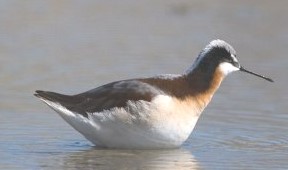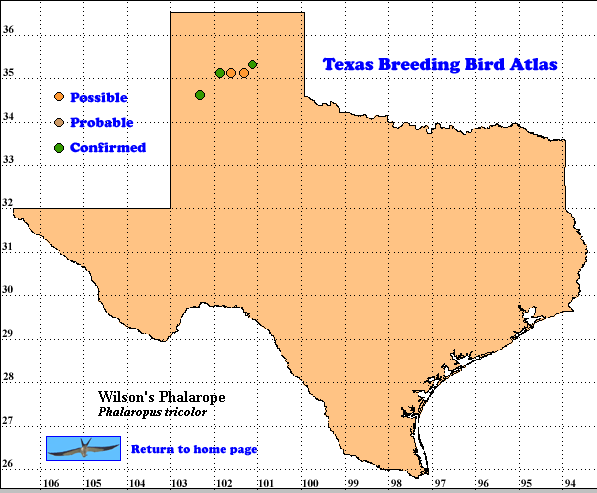Phalaropus tricolor
Wilson’s Phalarope is the only solely New World resident among the 3 phalarope species. It is found in inland habitats in contrast to the high Arctic breeding grounds and pelagic winter ranges, of the other two species (Colwell and Jehl 1994, Rubega et al. 2000, Tracy et al. 2002).
DISTRIBUTION. During the 1987-1992 field work seasons of the TBBA project, atlasers found 3 confirmed and 3 possible breeding sites for Wilson’s Phalaropes in the Panhandle. The first breeding was reported from Carson County in 1980 with a few more records since (Seyffert 2001). In Oklahoma atlasers found 3 probable breeding sites and one questionable confirmed site, all in the Oklahoma Panhandle. Because of the small area involved, the latter observation of juveniles associated with a small flock of adults in late July, might have been birds who bred in a nearby state (Gall 2004).
North American Breeding Bird Survey (BBS) data show breeding season populations in the 4 southwest Canadian provinces with the range extending south to Nebraska, Colorado, Utah, Nevada and eastern California. The highest relative abundances, 3-10 phalaropes per route, were found in southern Alberta, Montana and North Dakota (Sauer et al. 2008). Breeding has also been reported in scattered locations outside this range. Most Wilson’s Phalaropes winter in western and southern South America from Peru to Argentina (Colwell and Jehl 1994, Am, Ornithol. Union 1998).
SEASONAL OCCURRENCE. Spring migrant Wilson’s Phalaropes are common to abundant from late March to late May throughout Texas. Although breeding records are few in Texas, the season is probably similar to that found by atlasers in Colorado (mid-May to early August; Nelson 1998). Fall migration occurs from late June to late October with winter visitors rare to casual, mostly in the southern half of the state (Oberholser 1974, Lockwood and Freeman 2004).
BREEDING HABITAT. In Colorado breeding evidence for Wilson’s Phalaropes came primarily from marshes lined with emergent vegetation, lakes with open shorelines and hayfields (Nelson 1998). Across North America these phalaropes breed in wetlands of the interior, including sparse to dense vegetation of uplands and marshes, and roadside ditches. Nests, initiated by the female, are located within 100 m (330 ft) of wetlands in tall, dense, heterogeneous vegetation. One or both birds scrape a shallow depression with an outside diameter of 9–13 cm (3.6-5.2 in) and an inside diameter of 7–9 cm (2.8-3.6 in). Some nests are lined with grass. In the the female usually lays 4 buff eggs, marked with brown dots, spots and irregular blotches (Harrison 1979, Colwell and Jehl 1994). The first reference contains a picture of a nest with eggs
After the third egg is laid, the male begins incubation which lasts 23 days. The precocial young are fully feathered with down and can run, swim and feed themselves. They are brooded and protected by the male as they grow. By late August they begin migration to South America although not yet fully grown (Colwell and Jehl 1994).
STATUS. Breeding observations in the Panhandle since 1980 (Seyffert 2001) and TBBA data contrast with Oberholser”s (1974) map showing only a single summer record there. The difference may be due to the presence of more skilled observers now. BBS data from 263 routes suggest a +1.3% annual population change for 1980-2007 (Sauer et al. 2008). Protection of interior wetland habitats in Texas, particularly in the Panhandle, should help assure the future of Wilson’s Phalarope in this state.
Text by Robert C. Tweit (2009)
Literature cited.
American Ornithologists’ Union. 1998. Checklist of North American birds, 7th ed. Am, Ornithol. Union, Washington, DC.
Colwell, M. A. and J. R. Jehl, Jr. 1994. Wilson’s Phalarope (Phalaropus tricolor), The Birds of North America Online (A. Poole, Ed.). Cornell Lab of Ornithology; Ithaca, NY. Retrieved from: http://bna.birds.cornell.edu/bna/species/083
Gall, B. L. 2004. Wilson’s Phalarope (Phalaropus tricolor). In Oklahoma breeding bird atlas, pp. 156-157 (D. L. Reinking, ed.). University of Oklahoma Press, Norman.
Harrison, H. H. 1979. A field guide to western birds’ nests. Houghton Mifflin, Boston, MA.
Lockwood, M. W. and B. Freeman. 2004. The TOS handbook of Texas birds. Texas A&M University Press, College Station.
Nelson, D. L. 1998. Wilson’s Phalarope (Phalaropus tricolor). In Colorado breeding bird atlas, pp. 186-187 (H. E. Kingery, ed.), Colorado Bird Atlas Partnership, Denver.
Oberholser, H. C. 1974. The bird life of Texas. University of Texas Press, Austin.
Rubega, M. A., D. Schamel and D. M. Tracy. 2000. Red-necked Phalarope (Phalaropus lobatus), The Birds of North America Online (A. Poole, Ed.). Cornell Lab of Ornithology; Ithaca, NY. Retrieved from: http://bna.birds.cornell.edu
Sauer, J. R., J. E. Hines, and J. Fallon. 2008. The North American breeding bird survey, results and analysis 1966-2007. Version 5.15.2008. USGS Patuxent Wildlife Research Center, Laurel MD < http://www.mbr-pwrc.usgs.gov/bbs>
Tracy, D. M., D. Schamel and J. Dale. 2002. Red Phalarope (Phalaropus fulicarius), The Birds of North America Online (A. Poole, Ed.). Cornell Lab of Ornithology; Ithaca, NY. Retrieved from: http://bna.birds.cornell.edu/bna/species/698

